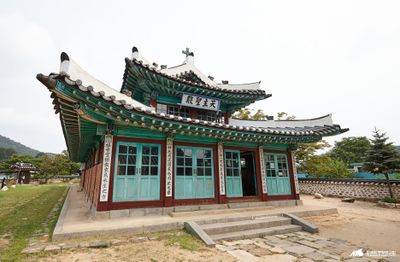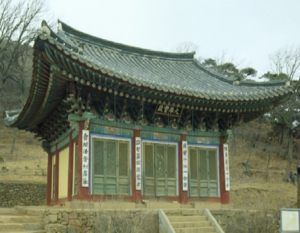GGHS 2019 Winter - Team 3
Religion in Ganghwa
목차
Team
| No. | Team Topic | Teacher | Role | Name (Korean) | No. of Students |
|---|---|---|---|---|---|
| 3 | Buddhism on Ganghwa (불교) |
Ritika | Leader | 박이○ | 8 |
| Vice-Leader | 유예○ | ||||
| 조수○ | |||||
| 김은○ | |||||
| 최축○ | |||||
| 이신○ | |||||
| 이승○ | |||||
| 김승○ |
Religion in Ganghwa
Religion
Here you can put whatever text and photo materials you would like relating to your topic. Feel free to include subheadings.
Anglicanism in Ganghwa
Anglicanism
Religious reformist Martin Luther and others influenced England in the 1520s, raising the movement for church reform in England. Even before the British Reformation of religion, a movement for church reform was being carried out. In particular, opposition to the Roman Catholic Church, which ruled England at that time, and the anti-clericalism movement were already taking place everywhere. Anglicanism was established against this background. The present great asset of the Anglicanism is the The Book of Common Prayer, that contains the Liturgy of the British Anglicanism. The Book of Common Prayer is still an important foundation for Anglican faith, worship, theology and spirituality, and is the basis of all the rituals of Anglican Church. Korea's Anglican Church of Korea uses a translated version of the book in Korean.[1]
The Background for establishment of Ganghwa Anglican Curch
The history of the Ganghwa Anglican Church began in 1889 when Mr. Koff was awarded the teaching position as the first Korean bishop. At that time, there was not a single believer in korea. It was in Ganghwa on June 13, 1896 where Koreans were first baptized. With such a background, the Anglican Church of Korea was the first to build a church in Ganghwa. Therefore, Ganghwa Anglican Cathedral history is old, and it is the oldest existing Hanok church building in Korea It was constructed with a bold combination of Western European style of Basilica and Oriental Buddhist temple style. The interior space of the church followed the pattern of the Basilica, while the exterior and outer space followed the pattern of Buddhist temples. A royal carpenter who participated in the construction of Gyeongbok Palace was in charge of the construction. The Anglican Church in Ganghwa not only shows the will of the early missionaries to naturalize themselves with the local culture but also provides a glimpse of the history of Korean Christianity. [2] [3]
Daejonggyo in Ganghwa
Daejonggyo
Daejonggyo is a religion that believes in Dangun, was created by Nacheol who was a religious activist at the Japanese occupation period. The Daesunggyo was founded because it has the driving force to be strengthen the nation’s foundation and revitalize its people during national crisis. The fundamental doctrines of Daejonggyo are the three laws (止, 調, 禁) and 三眞歸一 (性, 命, 精). Since it was founded during the Japanese colonial era, it has contributed more to the anti-Japanese independence movement than to its role as a religion. Daejonggyo is also the religion that created the National foundation day of Korea. [4]
Chamseongdan Altar in Ganghwa
Chamsungdan Altar is the place where a rituals, or jeecheon, are held to worship the sky and perform ancestral rites. Each Kingdom established an opportunity to solidify and unite its members through the Jechon event, and this tradition was continued during the Goryeo and Joseon periods. During the Goryeo and Joseon Dynasties, people held rituals in the state under the name of the king. There were regular and irregular rituals, regular rituals were held in spring and autumn. The purpose of the rite is believed to be to pray for the comfort and peace of the nation. Irregular rituals were held frequently in the event of natural disasters such as foreign invasions or droughts. Dangun Wanggeom, the founder of the Korean people, is known to have been built as an altar in short time of 51 years (BC2283). [5]
[6]Chamseongdan Altar in history
-On the <Korean history, 東史> of Lee Dong-hwan's { Susanjip } during the reign of Joseon Dynasty, it says Dan-gun built a castle on the sea and Manisan hills and built a platform and called Jecheon-dan.
- After repairing the Chamsongdan Altar, some say, "The place where Dangun built an altar and held a memorial service to Hanul."[7]
-The Chamsungdan Altar is reported to be an altar built by Dangun to offer sacrifices to the sky.
-It is said that the altar was built in a short span of 51 years by King Dan in BC 2283 to hold a memorial service in spring and fall for peace and development of the people.
-There is a record that Wonjong of Goryeo held a memorial service at Heungwang Palace in Marisan Mountain.
-It is recorded that, as being repaired in 11th year (1270) of King Wonjong of Goryeo Dynasty, and in 1639, the platform collapsed and was replaced in 1939 and also repaired in the 26th year (1700) of King Sukjong.[8]
Buddhism in Ganghwa
Buddhism
a religion that establishes Buddha as the head of religion and his teachings are considered the tentets. ( http://www.doopedia.co.kr)
Jeondeungsa Temple
- Jeondeungsa (delivering illegal lanterns) (history) In response to Mongol invasion, the Goryeo royal family designated a temporary town on Ganghwado Island and built a palace. During that period, the construction of a house within the premises of Jeondeungsa Temple was inevitable to promote the safety of the king along with geomancy theory (1232) In the 46th year of King Gojong's reign (1259), Jinjongsa Temple was established during the Goguryeo Period and reappeared in history. According to Koryoosa, there is a record of 46 years of King Gojong's reign (1259), the king ordered the construction of a house in Samrangseong Fortress five years later (1264), and that "the king opened the Daepbulseong Fortress, a Buddhist event that repels all kinds of disasters in the country with Buddha's mercy." The royal family of Goryeo built a temporary house inside Samrangseong Fortress and reconstructed Jinjongsa. (1266). King Chungnyeol's in his 8th year (1282) changed the name of the temple and called it' Jeondeungsa'.The Goryeo royal family was deeply interested in Jeondeungsa Temple, and the according to the geomancy theory the terrains of jeongjok mountain has established itself as a very tranquil area. The geomancy theorists claim that,that if Manisan Mountain is a grandfather, then Jeongjok mountain is a grandmother, and that it embodies such strong energy of wellness that it can’t be damaged even during a war.
-Information about Jeondeungsa The temple is divided into Daewungjeon, Yaksajeon and Bumjong. Daeungjeon Hall is designated as National Treasure No. 178, while the Yaksajeon Hall is a treasure No. 179 and the Bumjong Treasure No. 393, as well as national historic relics and tangible cultural properties designated by Incheon City. And Jeondeungsa operates various temple stay programs for both domestic and foreign people.
(http://www.jeondeungsa.org/ )
Tripitaka Koreana
In 1231, Mongolia invaded Korea, and the Choi administration moved its capital to Ganghwa to defend themselves from the Mongol invasion. During the war with Mongolia, the people of Ganghwa had internalised the idea that they had defeated the enemy with the power of Buddha by publishing first edition of the Tripitaka Koreana while the Kitan were invaded Korea. similarly, during the war with Mongolia, they published Tripitaka thinking that it will help them to beat Mongolia like the war with the Kitan. The value and prestige of the production of Tripitaka Koreana is shown in its purpose, which was published to defeat Mongolian army and to unify the commoner. The purpose of production is to overcome the invasion of Mongolia by the power of Buddhism. It contains the nobility of protecting the country. [9]
Map(s)
Network Graph(s)
- SAMPLE: VH2018_Religionreference.lst
- YOUR TEAM GRAPH: GGHS2019W_Team3.lst
References
- 인천광역시 문화유산 - 영문 해설문 포함 (한국학중앙연구원)
- ↑ 출처 [위키백과 성공회
- ↑ 출처 [네이버 지식백과] 성공회 강화성당 (한국민족문화대백과, 한국학중앙연구원)
- ↑ 출처 [네이버 지식백과] 대한성공회 강화성당 - 동서양 건축 양식이 빚어낸 걸작
- ↑ 출처 [두산백과대종교 (Daejonggyo, 大倧敎)]
- ↑ 출처 네이버 [지식백과참성단]
- ↑ 출처 [한국민족문화대백과사전참성단 사진]
- ↑ 출처 [네이버지식백과참성단]
- ↑ 출처 [한국민족문화대백과사전참성단]
- ↑ 출처 [유네스코 한국위원회] 해인사 장경판전



